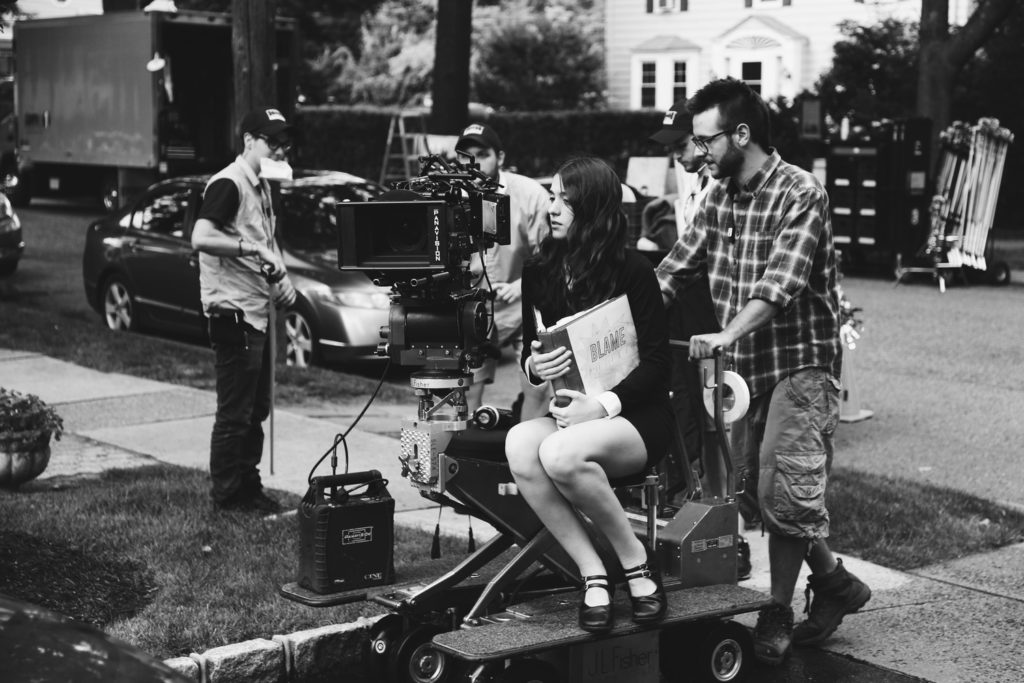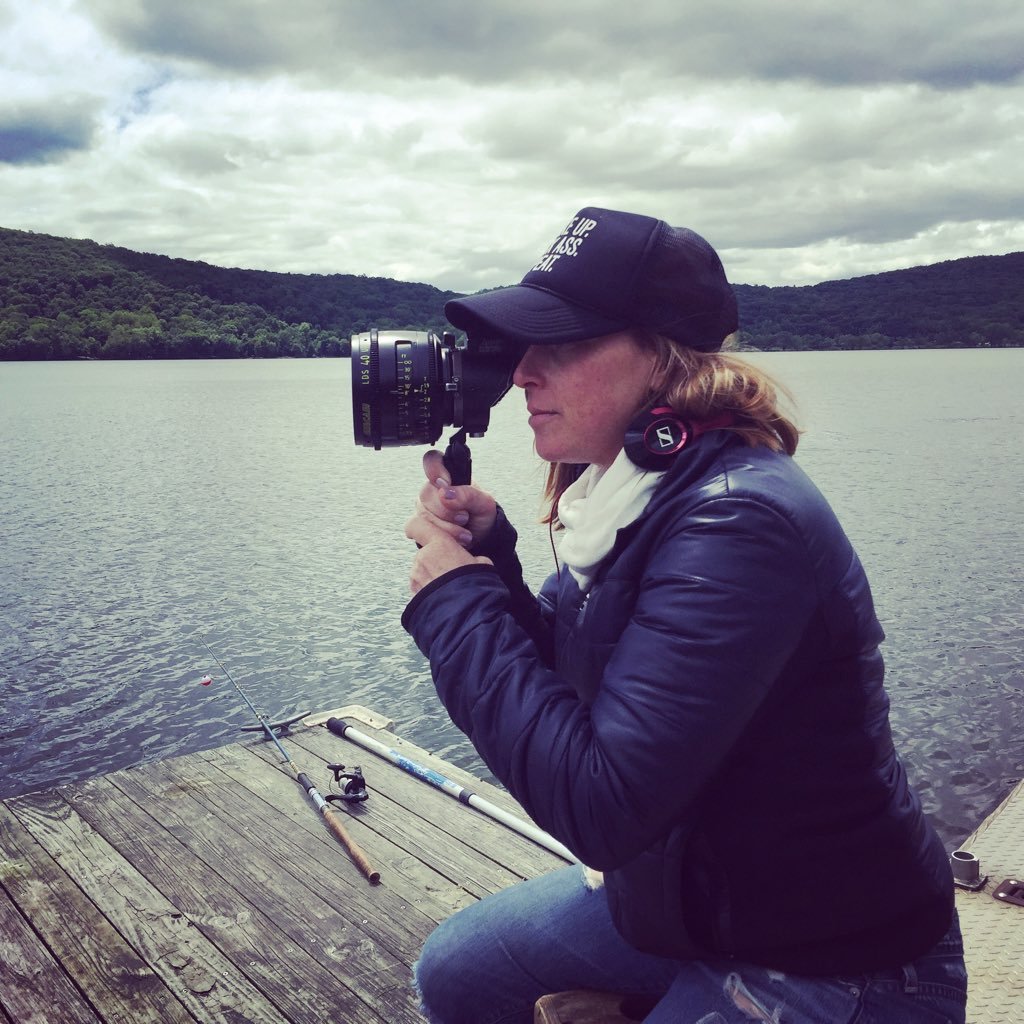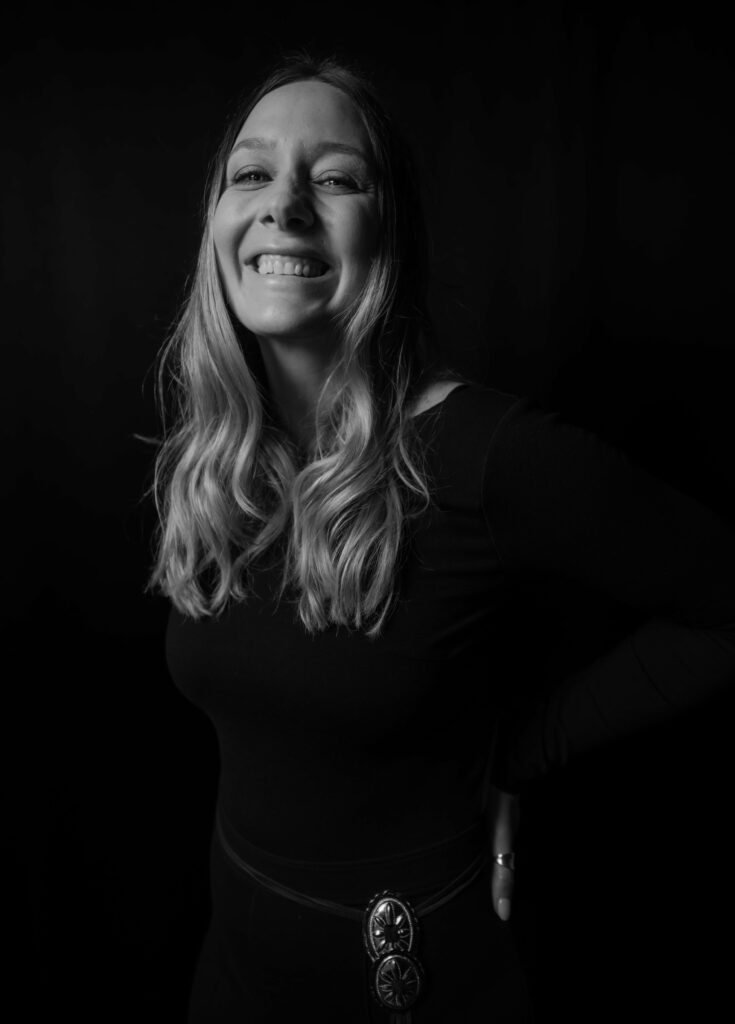Writing, directing, producing, editing, and starring in your own feature film is a lot to take on at any age. With the new feature BLAME, QUINN SHEPHARD managed to do it all before her 21st birthday. Shephard has been acting professionally since the age of four and started writing screenplays as a teenager. In 2015, she directed her first short film, Till Dark. For her first feature, Shephard looked back a few years to her high school days for inspiration – in the artistic sense (she had written the first draft of the script during her sophomore year), but also in the logistical sense (she shot the film at her former high school in Metuchen, New Jersey).
In Blame, Shephard portrays Abigail, a teenage outcast who strikes up a taboo relationship with her substitute teacher (Chris Messina) and sparks a rivalry with mean girl classmate Melissa (Nadia Alexander) over the school production of The Crucible. Blame premiered at the 2017 Tribeca Film Festival, where Alexander won the Best Actress award (and where Shephard co-hosted SAGindie’s filmmaker party!). Samuel Goldwyn Films will now release Shephard’s film to the masses, in select theaters and on VOD January 5, 2018.
We had the chance to talk with Blame filmmaker/star Quinn Shephard about the lessons she learned making her feature directorial debut.
——
COLIN McCORMACK: The Crucible is a big thread throughout the film. When did you first become familiar with the play?
QUINN SHEPHARD: I did a production of the play when I was 15 at a regional theater in New Jersey and it was the first adult role that I had ever played. I’ve been a professional actor since I was a kid, so I had played a lot of kids and that sort of thing. And at that age, it was my first opportunity and also my first time on stage where I was able to play such a womanly role. I just found that it had a really strong influence on my own coming-of-age and the way that I perceived myself, and that was very interesting to me as a writer because I was always a very Method actor and I got really into character, especially when I was younger. It was almost like a way for me to cope with high school and being a teenager and all the trauma that comes along with that [laughs]. It gave me a strength that I didn’t always feel just being myself when I embraced a character. And I felt [The Crucible‘s] Abigail was my first role that gave me a way into my own power as a young woman instead of as a kid. It was very interesting to me and that was part of the reason why I got so fascinated with the play and the character.
CM: You started writing the first draft of Blame while you were still in high school. At what point did you start to consider that it wasn’t just a side project, that it actually had the potential to be a movie you could make?
QS: I had always hoped it would be a movie I could actually make. My family was always extremely supportive of me being an artist and making films and that that was what I wanted to do for a living. And I don’t think I ever really seriously considered having a fallback plan, or what I would do if I wasn’t successful. I started making short films when I was 12 and I was really passionate about film and I kind of always knew and felt like I was going to be a filmmaker. So I think because my parents treated it like such a feasible and logical thing when I brought them the script, which I don’t think many people would do if their kid was like, “I’m going to make a feature film!” I think most of the time they would try to talk their kid out of that, which is not a bad idea because it’s very hard! But instead, my family was really supportive and like, Yeah sure, okay. Why can’t you? And my mom really embraced it and started working with me on it all the time, and I guess I just always thought, This is going to be the first film that I make. And I really believed in myself and in some ways looking back, I can’t believe that I pulled it off. But at that age, I just didn’t have a lot of self-doubt. Because I loved film so much it felt like I would just work as hard as I needed to to get where I wanted to be.
CM: Youth is a valued quality, especially in the acting world. But sometimes people can equate youth with inexperience. Did you face any resistance in being taken seriously as a filmmaker because you were so young?
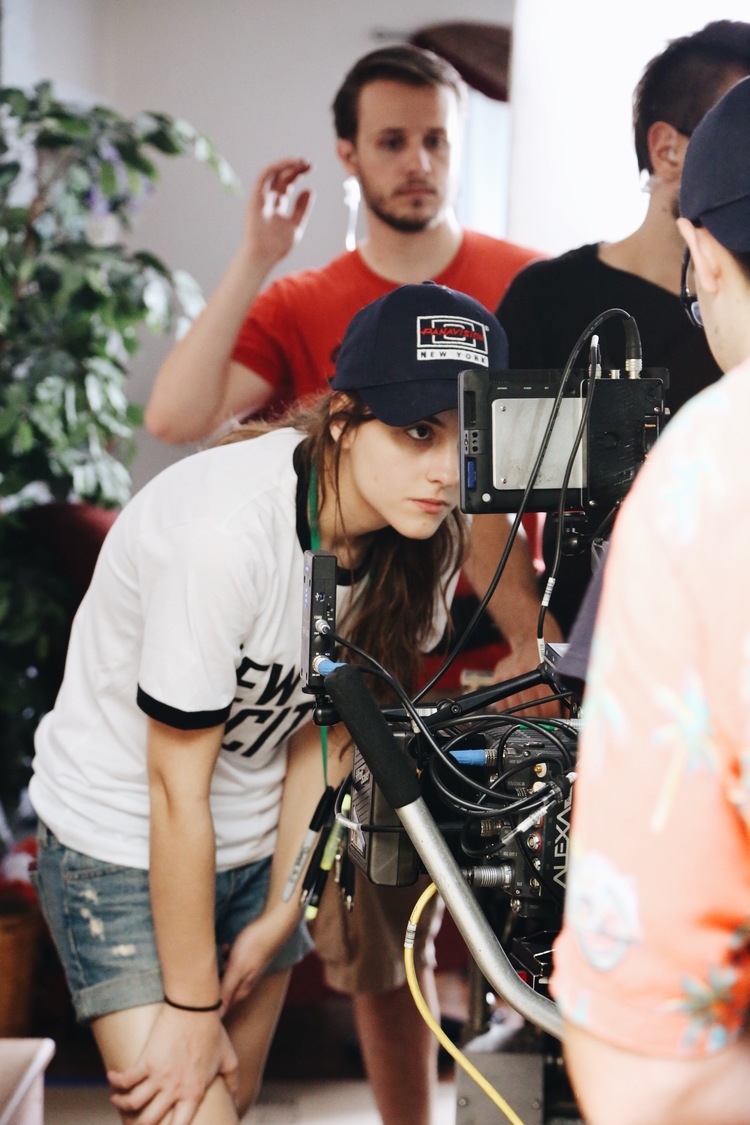
QS: It was my biggest fear going in that I was going to be perceived as too young. Basically, I was a teenage girl when I was taking the film out for financing and trying to get investors, and it was my biggest fear that I was going to be on set and everyone was going to be like, Why is there a kid here running this set? But what I will say is that I had a tremendous amount of support and love and encouragement and respect from the creative team that I worked with. All of my actors and the whole creative crew were very embracing and they understood what they were getting into when they signed on to a very low-budget film being directed by a 20-year-old girl. And they all just seemed to kind of take it in stride. I really studied up and I prepared because I didn’t want to come off as naïve, so when I got to set and we started talking about shots and going through lookbooks and working together, it just became not something you think about after the first meeting. I’m sure the first time they met me they were like, Oh my God, she’s so young, but after that, you get past it and you just focus on the work and kind of forget. At least from my perspective, that’s what I hoped, that people would forget about my age and just focus on what I was saying. Because in my mind, all you can do as a filmmaker is prepare as best you can and I definitely did do that.
CM: Your mom [Laurie Shephard] is your producing partner and the casting director and shares a story credit. Could you describe your working relationship and how you guys became professional collaborators?
QS: Yeah, like I said she just sort of jumped in with me when I was really young and was very supportive of me at a time when a lot of people wouldn’t have been and would’ve told me I was crazy. We just started working together and it felt natural because we both really cared about the story, we both really cared about the characters. They were characters that I created, but then really became both of ours as time went on. The script that I wrote the first draft of when I was 15 is wildly different from the film as it is now, and I’m definitely not the only person who can take credit for that because I surely matured as a writer, but at the same time I was getting an amazing amount of ideas and notes and collaboration from my mom. It became kind of a hobby, or an extension of our relationship, like after school when we had downtime we would sit and talk about the characters as if they were people that we knew. And we would talk about who we wanted to cast and what we wanted it to look like as if it was going to happen. We’d make a wish list of actors and sort of entertain that there was a way we could pull it off. And I’m still shocked that we did.
CM: Like you said, you’ve been acting since you a kid. When you were coming up as an actress, did you work with many female directors?
QS: You know, thinking about it… No. No, I really didn’t work with a lot of female directors as a kid. I didn’t work with a lot of female directors in television either. I’m working with more women now and I’m seeing more – even in auditions and meetings and stuff – I’m seeing more women now in the last two or three years than I have definitely at any other point in my career. I think it’s really great that so many networks have taken initiative with episodic directing like, We’re going to have a 50/50 ratio for women and People of Color. I just think that it’s so important that there’s diversity behind the camera and not just in front of the camera.
CM: Speaking of behind the camera, how did you go about finding your crew?
QS: Well, we did have a lot of budget constraints and we were looking for a group of people who were very talented and typically worked on films with much bigger budgets. So a lot of it was word of mouth. I was part of a women filmmaker collective that I spoke to quite a bit about trying to meet crew. I asked around. Honestly, I found crew when I worked on some sets. I would just go around to crew afterward any time I worked on a lower-budget New York production. I would go up and talk to people about my upcoming film and say, “Hey, I really liked working with you. Would you guys be interested?” If they weren’t available, then oftentimes they could refer me to someone who might refer me to someone else, and eventually you make your way down the chain and you end up with a crew. As far as our key creative crew, my DP [Aaron Kovalchik] had been attached for a few years, actually. He was someone I knew through a director and he came on board when I was 17, so he had been a longtime supporter of the project and had been super involved with me and taken a lot of time to create the visuals of the film and what we pictured. But as far as the entire crew, a lot of it was coming together in the weeks leading up to filming because we had so many people dropping out because they booked higher-paying gigs. So it was just chaos leading up to production [laughs]. I think our costume designer and our art director came on maybe like two weeks – if that – before the shoot.
CM: I’m always curious when I talk to actor-directors about what the casting process was like for them. Especially since it’s your first feature – you had cast your short film – but for your first feature, what was that like being on the other side of it?
QS: Honestly, casting is one of the most fun and awesome parts of the process. I love casting, and I also think it’s really important for me to have a very relaxed and comfortable room because I’ve been in so many different kinds of rooms as an actor when you’re in the final stages. So for me, when we did our chemistry reads for the actors I spent a lot of time with them, we did improv, I gave them props and snacks and all sorts of weird things just to make them loosen up. I took everyone in for about 15 minutes before each of them read for me individually. I just hung out with them and talked to them about whatever it was they were passionate about; music or Harry Potter or anything that they really wanted to talk to me about, just to get rid of the nerves. There are so many nerves when you walk in to audition for something. And my film was pretty small, it wasn’t a Martin Scorsese film, but I still think that in any situation, no matter how small the film is, there’s a certain level of nervousness that you feel. And it’s always my goal to get rid of that – on set, in the room for an audition, in any situation – as much as possible, because I think there’s a real vulnerability and openness you can get to with an actor if you take all of that out. So for me, it was just about being a friend. Some people say, Don’t make friends with your actors. But that’s terrible advice! You should be friends with your actors! That can only be applied if you have an actor who’s really difficult, and on Blame we didn’t have anyone who wasn’t there because they really wanted to be there. So it was my job to be their friend. I was in the trenches with them. So when the girls had to shoot a sex scene, I also had to shoot a sex scene in the movie. There was this idea of, Don’t make your actor do anything you wouldn’t do. I did everything that way, I never put an actor in a situation that I would not have wanted to be in myself.
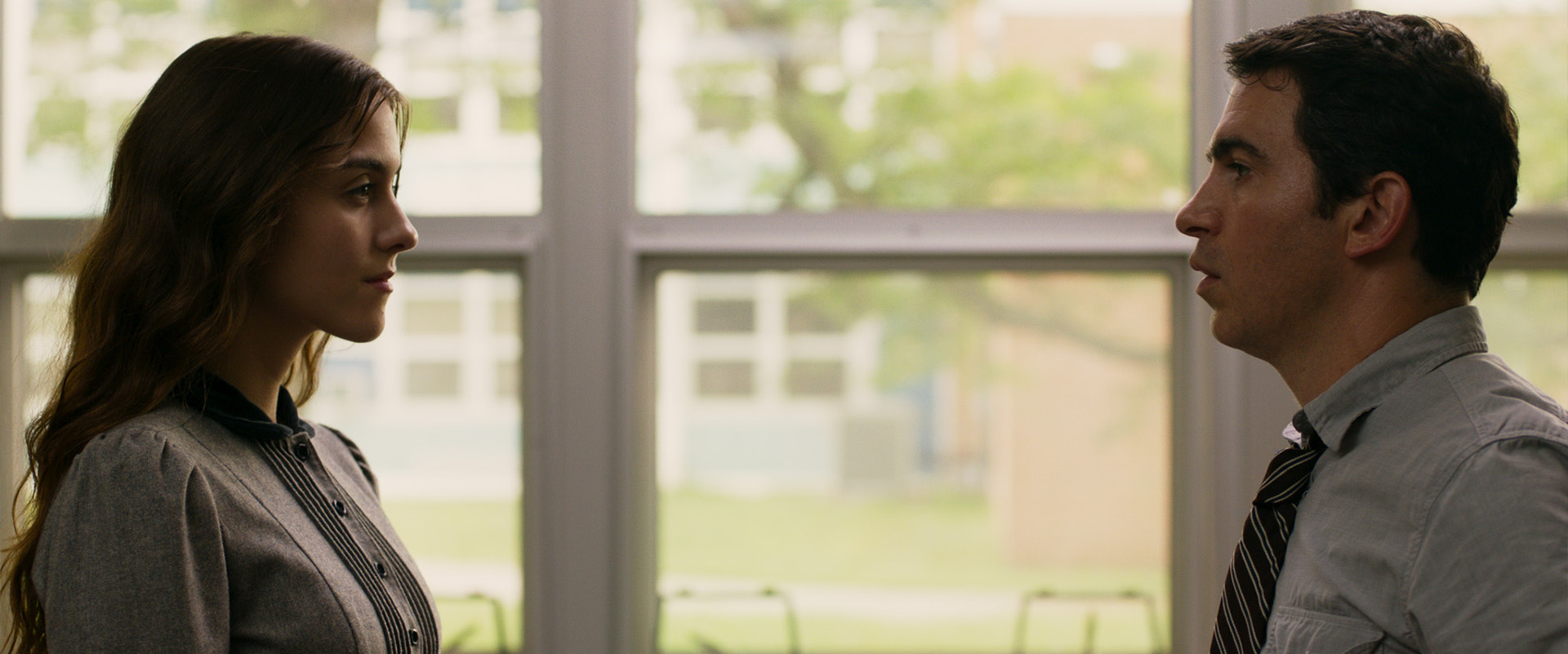
CM: How did you end up getting Chris Messina attached?
QS: It’s kind of a funny story. My mom and I – he was our first choice for the role. My mom had mentioned him to me years before, and he had just sort of become our Jeremy mentally. But he did not know this [laughs]. Because we had never talked to him or met him before. So I had asked around trying to get his email from somebody because I knew a lot of people who had worked with him, and none of them had his email. And I finally found someone who had Jennifer Todd’s email, his wife who’s an incredible producer. I had also never met her, so I wrote her a letter like, Please send to Chris Messina! And I basically sent him the script and test footage we had done and a letter [explaining] that the first movie my mom and I had really noticed him in was Sam Mendes’ Away We Go, and why we wanted him to play the role and the blend of masculinity and vulnerability that he has. I just spoke from the heart and told him why we didn’t want anybody else; we had no backup, we were just really believing that this might be something. And he got back to me within like two days, saying he had read the script and he wanted to talk. I happened to be in L.A. at the time for a completely unrelated reason, and I said, “I’m in L.A. if you want to get a coffee,” and he said, “Yeah, sure.” So we met up and he talked to me for about an hour, and he asked me, “How much improv do you like to do? How much input am I going to have on the character? How much freedom will we have?” And I was like, “Lots of freedom! Lots of improv! Whatever you want, we’re going to make it happen.” And he was like, “Great, I’d like to do the film. Let’s see if it works out with my schedule.” And it was a lot of craziness to get him on the film. He only filmed seven days on the movie, so we had to move very quickly when he was there. But he ended up making it work between two movies. He flew in the day before and flew out the day after to start some other films. It was crazy, but it was pretty amazing that he did it. He’s a true supporter of indie film. It’s absolutely amazing.
CM: How long was your shoot in total?
QS: 19 days. It was fast.
CM: What was it like filming at your old high school? Was it exciting for your hometown to have a movie being shot there?
QS: Oh yeah, they were so excited. Which was so sweet. I grew up near [New York City], but I didn’t grow up in the City, obviously, and I just think you don’t get to have that small-town support system when you grow up in the City. They were so excited and gave us locations for free and just really went out of their way to make this film happen. It was pretty amazing and I think they’re all really excited with how the film turned out, those of them who have seen it.
CM: In terms of your directing style, were there specific tips or qualities you picked up from certain directors that you had acted with in the past?
QS: That’s interesting. The funny thing is I think the person I learned the most from in how to talk to actors was my mom because she coached me for so many years. And she just had a way of getting to me emotionally that was really different. I worked with a lot of directors – I’ve worked with a lot of really talented directors as well and over the last few years I had the benefit of working with some really great auteurs – but when you work in TV, sometimes there’s this perception of, Don’t fix something if it’s not broken. And I think directors don’t give [TV] actors notes always because they think, Well, they’re doing their job and I don’t have to give them a note. And for me, when I’m directing it’s not about “good” or “bad.” It’s about getting to the core of the scene and finding out if there’s more within that person. My mom was always great at that when she coached me for auditions, of knowing when I was capable of more than maybe a director I had just started working with would actually know. Because she knew me so well. So for me, the technique of working with actors is getting to know them as fast as possible, getting to understand what they have inside of them, and it’s just pushing them – gently – but pushing them to get there. My mom could always get more of a performance out of me than a lot of directors could because she knew what I was capable of. That’s the way to get something really powerful from someone, but it’s hard because it requires a director to really pay attention, to really get close to their actors.
CM: Was that easier in terms of having so many of your cast be so close to your age? In terms of building that camaraderie?
QS: Yes, absolutely. There was a peer relationship there, so a lot of the boundaries that you usually feel with a director were sort of taken down because we were all doing these things together. I got to spend so much time with everyone, but especially with Nadia because she has such a difficult character arc and was also playing a character that was the polar opposite of who she innately is. So we had a lot of work to do, and she completely trusted me and put herself in my hands, so when I gave her really difficult or interesting or complicated notes or I made her go back to sense memory something she had confided in me, she just did it. She was so malleable as an actor, and that was amazing. I think that was because I was able to get really close with her. With Chris, I think he had a lot more of a sense of the character walking in and had a handle on it. But he also didn’t try to run the show. He came in and gave a lot of ideas and notes, but at the end of the day if I also gave him a note he would listen to me. He respected me as a director even though I was so much younger than he was and less experienced.
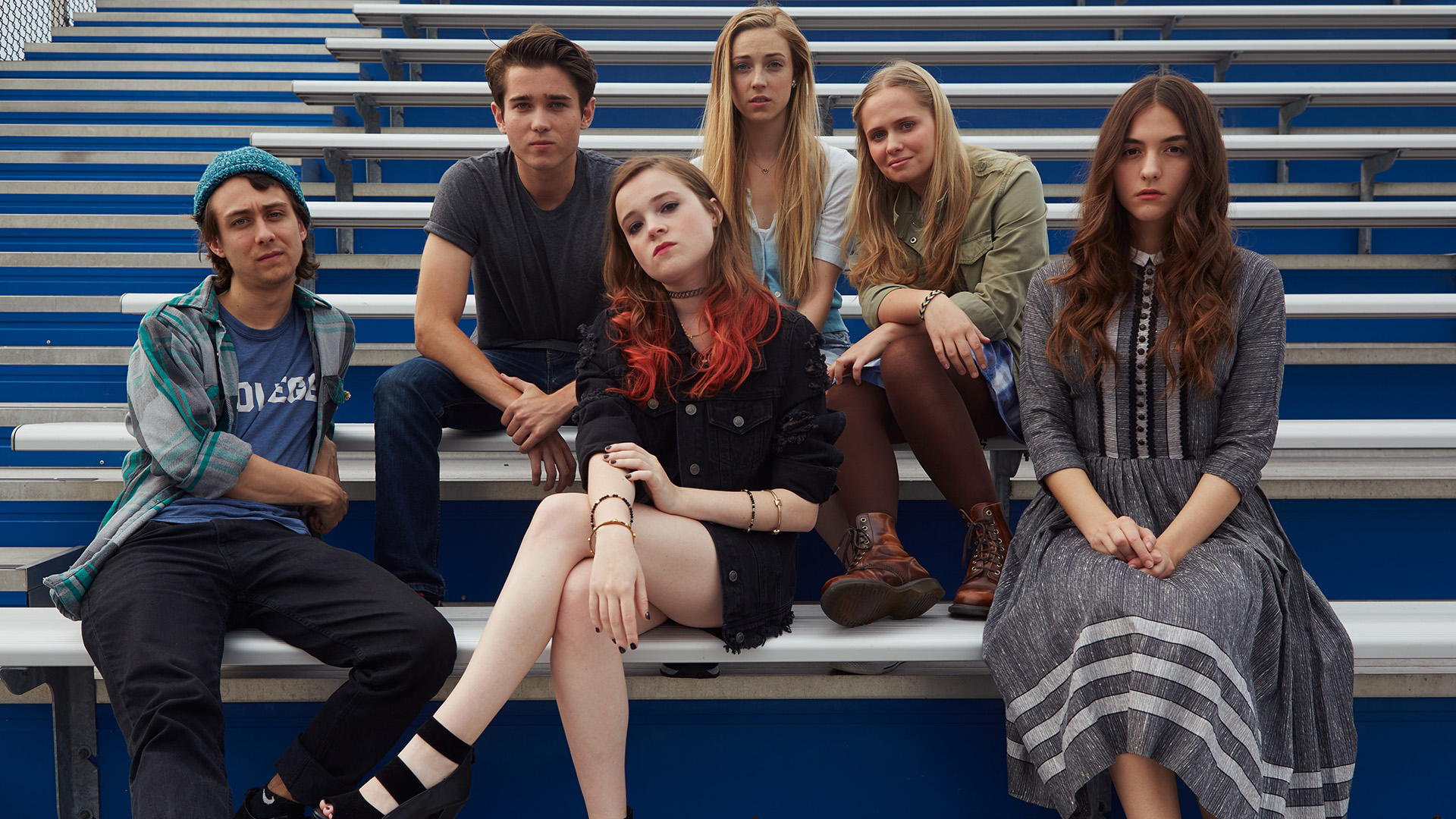
CM: With Nadia’s character, I had read you initially envisioned the character as more of the blonde popular cheerleader-type that maybe we’ve seen in movies more often, but you made her a little more edgy and out of the box [for Nadia]. Was that the first time you adjusted a character based on the actor?
QS: Yeah, it was. I think everyone that we cast was pretty much what I pictured. All of the other actors who joined the cast were pretty much what I envisioned when I was writing it. And I think with Nadia, I had this idea that was a lot more reflective of my age when I was writing it. It was a lot more trope-y and influenced by what I had seen repeatedly in films. When I read Nadia for it for the first time, she didn’t actually do a tape. She came in and did a chem read for her first audition for the character, so she was with the final cast. And it was really amazing because it was something that was so different from what other girls were doing and what I’d seen. Even she herself didn’t think she was right for it. She said her agents would never have even submitted her for the role. And it was just because it was so different, it immediately reminded me of girls that I’d known in high school. There’s this level of pretend that people like that play, where they create this persona, this shell that they can put on like armor that has this personality and this swagger and these clothes and these mannerisms. With Nadia, you could see the shell and you could also see the girl underneath. With a lot of the other girls that auditioned it felt like it came much more natural to them to be sexy and powerful and commanding, [but] with Nadia, there was still something about her that was like she was still trying to get used to it herself. And I think that was so fascinating to me. I said, “That’s high school. That’s what a girl in high school really seems like. She’s not just the hot girl who knows what she’s doing, she’s the girl who’s pretending that she is.” That was what really spoke to me and added so much more to the story. And ultimately we were really happy we tried that and that my mom had pushed me to see her for the role because she wasn’t what I initially pictured. I was like, “I don’t know, this isn’t going to work,” and it ended up being the best decision that we made.
CM: For you, what was the hardest part of directing and acting at the same time?
QS: It was so hard. [Laughs] It was honestly kind of horrible. I don’t think it’s something I would want to do again anytime soon. The fact that there are things you have to do for yourself as an actor when you’re working – there are things you have to do to get yourself into character that are horrible for a director to be doing. Like sometimes when you have to isolate yourself, put yourself in a moment, get yourself to an emotionally vulnerable place, that’s not a good move as a director. So oftentimes I would have to push myself emotionally for a scene and then I would be completely exhausted and raw afterward, and then have to go and run the set and set up lighting and I would just feel almost on the verge of a little bit of a breakdown. I would be so emotional from the scene and then have to go and be completely unemotional and be all business. That was really hard. I like the fact that it felt like I was part of something with all the other actors, I liked the unity of that. [But] there are so many other things you just don’t think about. You don’t think about that you’ll have to be having your morning production meeting while you’re going through Hair & Makeup. You don’t think about the fact that you’re going to have to take an hour-and-a-half out of your schedule in a 12-hour day or 10-hour day and be sitting and getting your hair curled while you’re going through a production book and talking to your costume designer and approving looks and you can’t move. You don’t think about if you’re shooting two cameras but you’re in a scene, you can’t look at an actor while they’re doing a reaction; you might not have time to watch playback so you’re kind of blindly directing. So that was very hard, for sure. It was a very ambitious decision to [act] in it, but it’s only because the character was very personal. It’s not something I typically would have done.
CM: In terms of the acting you’ve done on other projects since making Blame, do you think the way you approach acting or your relationship with directors has changed?
QS: Yeah, it has. In a lot of ways in a positive way, but in some ways in a negative way, I think. There’s a part of me that comes at acting more technically than I ever used to, and that can be hard. But it can also be great because I really understand so extensively what a director needs when they’re editing a film because I edited my film. And I really know a lot about matching action and giving people options in the edit and all of these things: blocking, playing to camera, getting the right light on your face, hitting the marks. There’s so much you think about when you’re making a film; a lot of time directors want the actors to be completely out of tune with this, they want them to be in another world. But at the same time, if you’re in tune to it, you can deliver a performance that’s extremely editable. So it’s a mixed bag. In a lot of ways, it’s given me an advantage because I know so much more about how a film is made and how it all comes together. But in some ways, there’s a part of you that thinks about things more technically than you used to, and you have to fight that. So I’ve had to sometimes put it away. Where I’m in my brain thinking about the camera and the lighting setup and wanting to look at the monitor and see how it’s all coming together, and then remembering, That’s not my job here. And I’m pretty good when I’m on someone else’s set saying, “I’m an actor, I’m not trying to direct the movie.”
CM: You published your lookbook for Blame on your website, which I could see being a useful resource for other filmmakers to look at and get a peek at the process of how you started developing the visuals of the film. Were there any useful resources or tools that you pulled from when you were starting out as a director?
QS: I’m glad you saw the lookbook! Actually, not for directing, but my mom read Producer to Producer like 10 times. That book is amazing. It’s so helpful. I think that’s the biggest one that we’re constantly telling people to read because if you ever think you want to make a movie, but you’re like, “How much work is it going to be?” And you read Producer to Producer, you will understand what kind of life you’re going to have for the next few years. So that was a huge resource for us because trying to go in and have a very well-run, legally-sound, well-budgeted, well-scheduled movie, when you have two completely inexperienced producers running the entire film, is very hard. So we really had to compensate for our inexperience by preparing and reading and just researching the hell out of everything that we did. So that was honestly our biggest resource. My mom is the one who did more of the “technical” producing side. She was very involved creatively as well, but I had so many hats that I was wearing on set, so she was responsible for more logistics than I was, and really that was her biggest resource.
CM: What’s next for you, on the filmmaking side or acting side?
QS: I have a few projects. I’m in a film this year at Sundance called The Miseducation of Cameron Post, as well as a film called Midnight Sun that’s going to be coming out. And I have two upcoming [writing/directing] projects that unfortunately I’m unable to speak about, but I can say I have one feature project and one TV project in the works that I am very excited about.
__
Thanks again to Quinn Shephard for talking with us about BLAME. Learn more about the film at Samuel Goldwyn Films’ website, or follow the film on Facebook, Instagram, or Twitter.
This interview has been edited for clarity.
If you’re an independent filmmaker or know of an independent film-related topic we should write about, email blogadmin@sagindie.org for consideration.

